Early Childhood Education: EDU20002 Assignment 3 Math Resources Folio
VerifiedAdded on 2022/08/25
|8
|1921
|18
Homework Assignment
AI Summary
This assignment presents a folio of resources for early mathematics education, examining items such as math-themed page borders, board games, tablets with interactive whiteboards, and an addition bus activity. The assignment details how each resource is used in early math development, its benefits, and limitations, referencing the Australian Curriculum and Early Years Learning Framework. Reflections on knowledge, practice, and engagement are provided, highlighting how these resources can be integrated into teaching strategies and how they align with social constructivist learning theories. The folio emphasizes the importance of play-based learning and the use of ICT to enhance numeracy skills in young children, providing evidence-based discussions on the effectiveness and practical application of each resource in a classroom setting, aiming to support and enhance young children's learning and their transition to school. The assignment also includes a list of references.
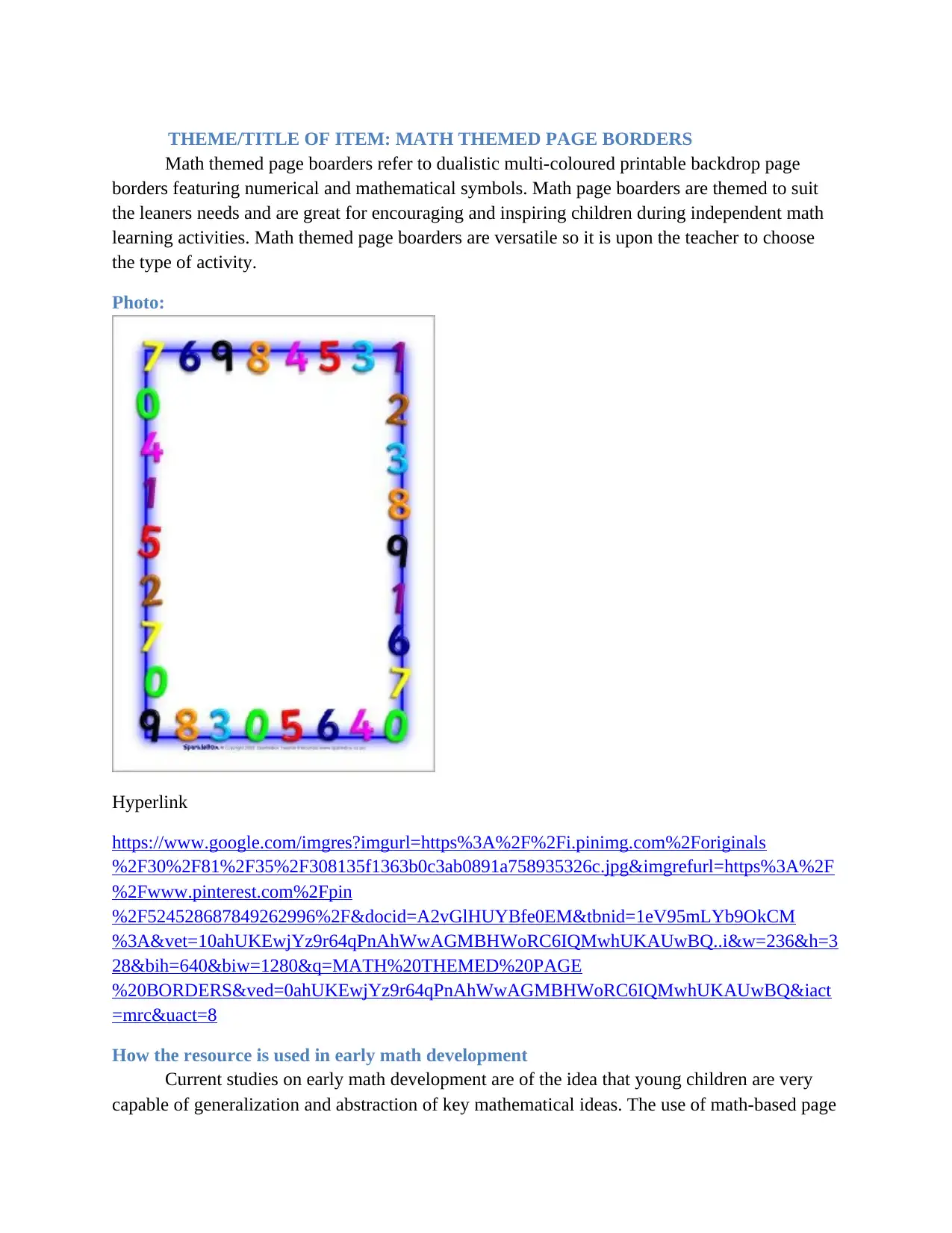
THEME/TITLE OF ITEM: MATH THEMED PAGE BORDERS
Math themed page boarders refer to dualistic multi-coloured printable backdrop page
borders featuring numerical and mathematical symbols. Math page boarders are themed to suit
the leaners needs and are great for encouraging and inspiring children during independent math
learning activities. Math themed page boarders are versatile so it is upon the teacher to choose
the type of activity.
Photo:
Hyperlink
https://www.google.com/imgres?imgurl=https%3A%2F%2Fi.pinimg.com%2Foriginals
%2F30%2F81%2F35%2F308135f1363b0c3ab0891a758935326c.jpg&imgrefurl=https%3A%2F
%2Fwww.pinterest.com%2Fpin
%2F524528687849262996%2F&docid=A2vGlHUYBfe0EM&tbnid=1eV95mLYb9OkCM
%3A&vet=10ahUKEwjYz9r64qPnAhWwAGMBHWoRC6IQMwhUKAUwBQ..i&w=236&h=3
28&bih=640&biw=1280&q=MATH%20THEMED%20PAGE
%20BORDERS&ved=0ahUKEwjYz9r64qPnAhWwAGMBHWoRC6IQMwhUKAUwBQ&iact
=mrc&uact=8
How the resource is used in early math development
Current studies on early math development are of the idea that young children are very
capable of generalization and abstraction of key mathematical ideas. The use of math-based page
Math themed page boarders refer to dualistic multi-coloured printable backdrop page
borders featuring numerical and mathematical symbols. Math page boarders are themed to suit
the leaners needs and are great for encouraging and inspiring children during independent math
learning activities. Math themed page boarders are versatile so it is upon the teacher to choose
the type of activity.
Photo:
Hyperlink
https://www.google.com/imgres?imgurl=https%3A%2F%2Fi.pinimg.com%2Foriginals
%2F30%2F81%2F35%2F308135f1363b0c3ab0891a758935326c.jpg&imgrefurl=https%3A%2F
%2Fwww.pinterest.com%2Fpin
%2F524528687849262996%2F&docid=A2vGlHUYBfe0EM&tbnid=1eV95mLYb9OkCM
%3A&vet=10ahUKEwjYz9r64qPnAhWwAGMBHWoRC6IQMwhUKAUwBQ..i&w=236&h=3
28&bih=640&biw=1280&q=MATH%20THEMED%20PAGE
%20BORDERS&ved=0ahUKEwjYz9r64qPnAhWwAGMBHWoRC6IQMwhUKAUwBQ&iact
=mrc&uact=8
How the resource is used in early math development
Current studies on early math development are of the idea that young children are very
capable of generalization and abstraction of key mathematical ideas. The use of math-based page
Paraphrase This Document
Need a fresh take? Get an instant paraphrase of this document with our AI Paraphraser
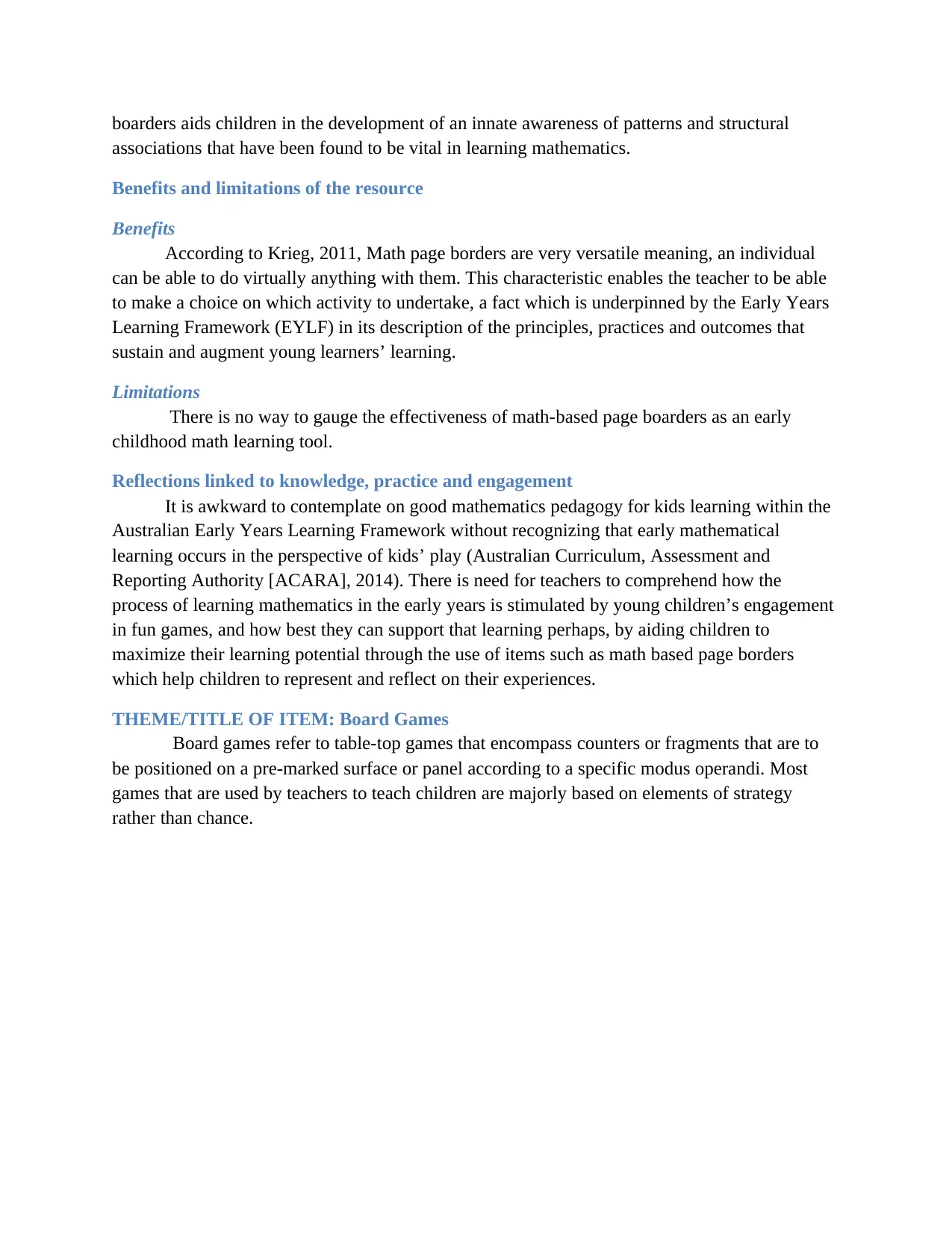
boarders aids children in the development of an innate awareness of patterns and structural
associations that have been found to be vital in learning mathematics.
Benefits and limitations of the resource
Benefits
According to Krieg, 2011, Math page borders are very versatile meaning, an individual
can be able to do virtually anything with them. This characteristic enables the teacher to be able
to make a choice on which activity to undertake, a fact which is underpinned by the Early Years
Learning Framework (EYLF) in its description of the principles, practices and outcomes that
sustain and augment young learners’ learning.
Limitations
There is no way to gauge the effectiveness of math-based page boarders as an early
childhood math learning tool.
Reflections linked to knowledge, practice and engagement
It is awkward to contemplate on good mathematics pedagogy for kids learning within the
Australian Early Years Learning Framework without recognizing that early mathematical
learning occurs in the perspective of kids’ play (Australian Curriculum, Assessment and
Reporting Authority [ACARA], 2014). There is need for teachers to comprehend how the
process of learning mathematics in the early years is stimulated by young children’s engagement
in fun games, and how best they can support that learning perhaps, by aiding children to
maximize their learning potential through the use of items such as math based page borders
which help children to represent and reflect on their experiences.
THEME/TITLE OF ITEM: Board Games
Board games refer to table-top games that encompass counters or fragments that are to
be positioned on a pre-marked surface or panel according to a specific modus operandi. Most
games that are used by teachers to teach children are majorly based on elements of strategy
rather than chance.
associations that have been found to be vital in learning mathematics.
Benefits and limitations of the resource
Benefits
According to Krieg, 2011, Math page borders are very versatile meaning, an individual
can be able to do virtually anything with them. This characteristic enables the teacher to be able
to make a choice on which activity to undertake, a fact which is underpinned by the Early Years
Learning Framework (EYLF) in its description of the principles, practices and outcomes that
sustain and augment young learners’ learning.
Limitations
There is no way to gauge the effectiveness of math-based page boarders as an early
childhood math learning tool.
Reflections linked to knowledge, practice and engagement
It is awkward to contemplate on good mathematics pedagogy for kids learning within the
Australian Early Years Learning Framework without recognizing that early mathematical
learning occurs in the perspective of kids’ play (Australian Curriculum, Assessment and
Reporting Authority [ACARA], 2014). There is need for teachers to comprehend how the
process of learning mathematics in the early years is stimulated by young children’s engagement
in fun games, and how best they can support that learning perhaps, by aiding children to
maximize their learning potential through the use of items such as math based page borders
which help children to represent and reflect on their experiences.
THEME/TITLE OF ITEM: Board Games
Board games refer to table-top games that encompass counters or fragments that are to
be positioned on a pre-marked surface or panel according to a specific modus operandi. Most
games that are used by teachers to teach children are majorly based on elements of strategy
rather than chance.
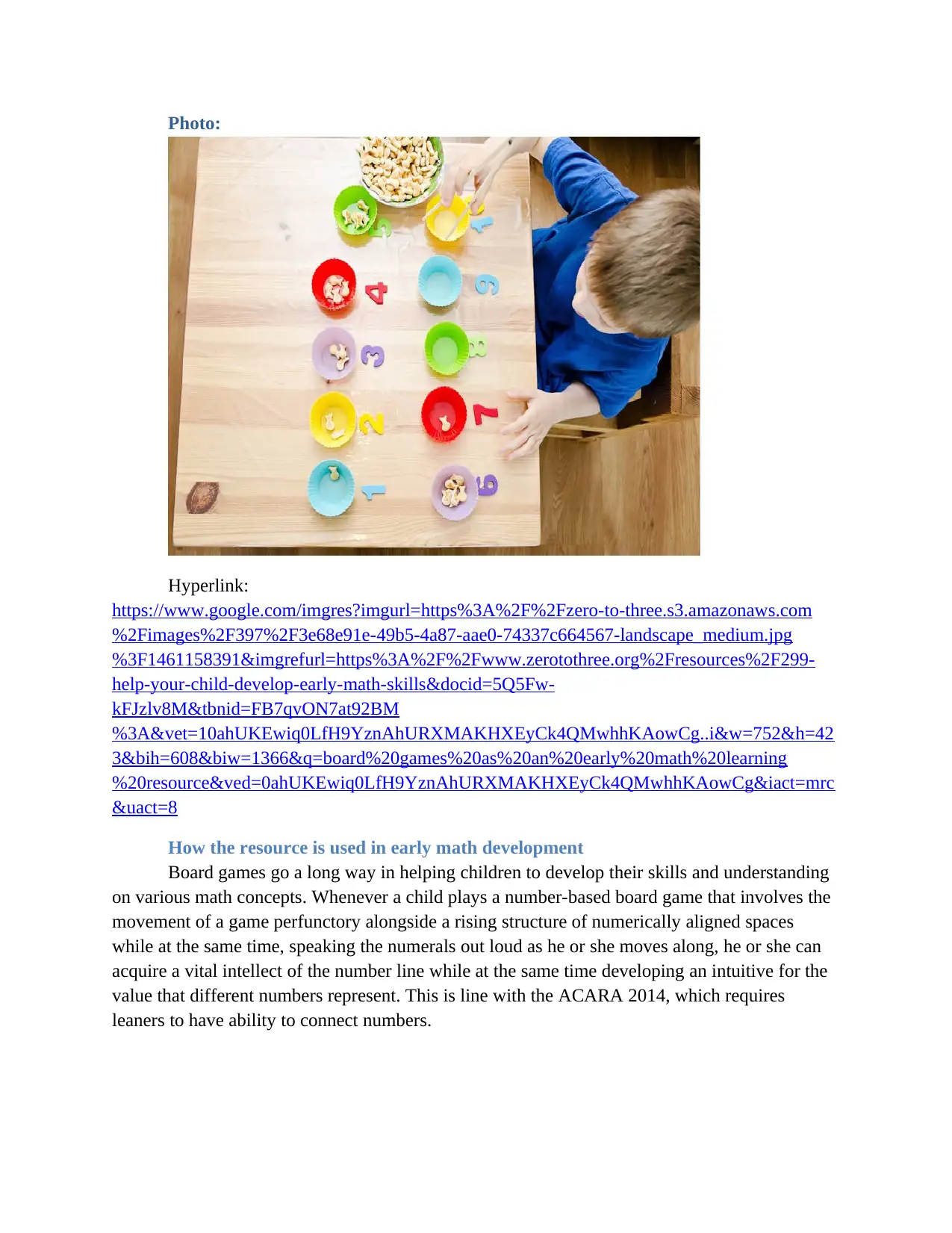
Photo:
Hyperlink:
https://www.google.com/imgres?imgurl=https%3A%2F%2Fzero-to-three.s3.amazonaws.com
%2Fimages%2F397%2F3e68e91e-49b5-4a87-aae0-74337c664567-landscape_medium.jpg
%3F1461158391&imgrefurl=https%3A%2F%2Fwww.zerotothree.org%2Fresources%2F299-
help-your-child-develop-early-math-skills&docid=5Q5Fw-
kFJzlv8M&tbnid=FB7qvON7at92BM
%3A&vet=10ahUKEwiq0LfH9YznAhURXMAKHXEyCk4QMwhhKAowCg..i&w=752&h=42
3&bih=608&biw=1366&q=board%20games%20as%20an%20early%20math%20learning
%20resource&ved=0ahUKEwiq0LfH9YznAhURXMAKHXEyCk4QMwhhKAowCg&iact=mrc
&uact=8
How the resource is used in early math development
Board games go a long way in helping children to develop their skills and understanding
on various math concepts. Whenever a child plays a number-based board game that involves the
movement of a game perfunctory alongside a rising structure of numerically aligned spaces
while at the same time, speaking the numerals out loud as he or she moves along, he or she can
acquire a vital intellect of the number line while at the same time developing an intuitive for the
value that different numbers represent. This is line with the ACARA 2014, which requires
leaners to have ability to connect numbers.
Hyperlink:
https://www.google.com/imgres?imgurl=https%3A%2F%2Fzero-to-three.s3.amazonaws.com
%2Fimages%2F397%2F3e68e91e-49b5-4a87-aae0-74337c664567-landscape_medium.jpg
%3F1461158391&imgrefurl=https%3A%2F%2Fwww.zerotothree.org%2Fresources%2F299-
help-your-child-develop-early-math-skills&docid=5Q5Fw-
kFJzlv8M&tbnid=FB7qvON7at92BM
%3A&vet=10ahUKEwiq0LfH9YznAhURXMAKHXEyCk4QMwhhKAowCg..i&w=752&h=42
3&bih=608&biw=1366&q=board%20games%20as%20an%20early%20math%20learning
%20resource&ved=0ahUKEwiq0LfH9YznAhURXMAKHXEyCk4QMwhhKAowCg&iact=mrc
&uact=8
How the resource is used in early math development
Board games go a long way in helping children to develop their skills and understanding
on various math concepts. Whenever a child plays a number-based board game that involves the
movement of a game perfunctory alongside a rising structure of numerically aligned spaces
while at the same time, speaking the numerals out loud as he or she moves along, he or she can
acquire a vital intellect of the number line while at the same time developing an intuitive for the
value that different numbers represent. This is line with the ACARA 2014, which requires
leaners to have ability to connect numbers.
⊘ This is a preview!⊘
Do you want full access?
Subscribe today to unlock all pages.

Trusted by 1+ million students worldwide
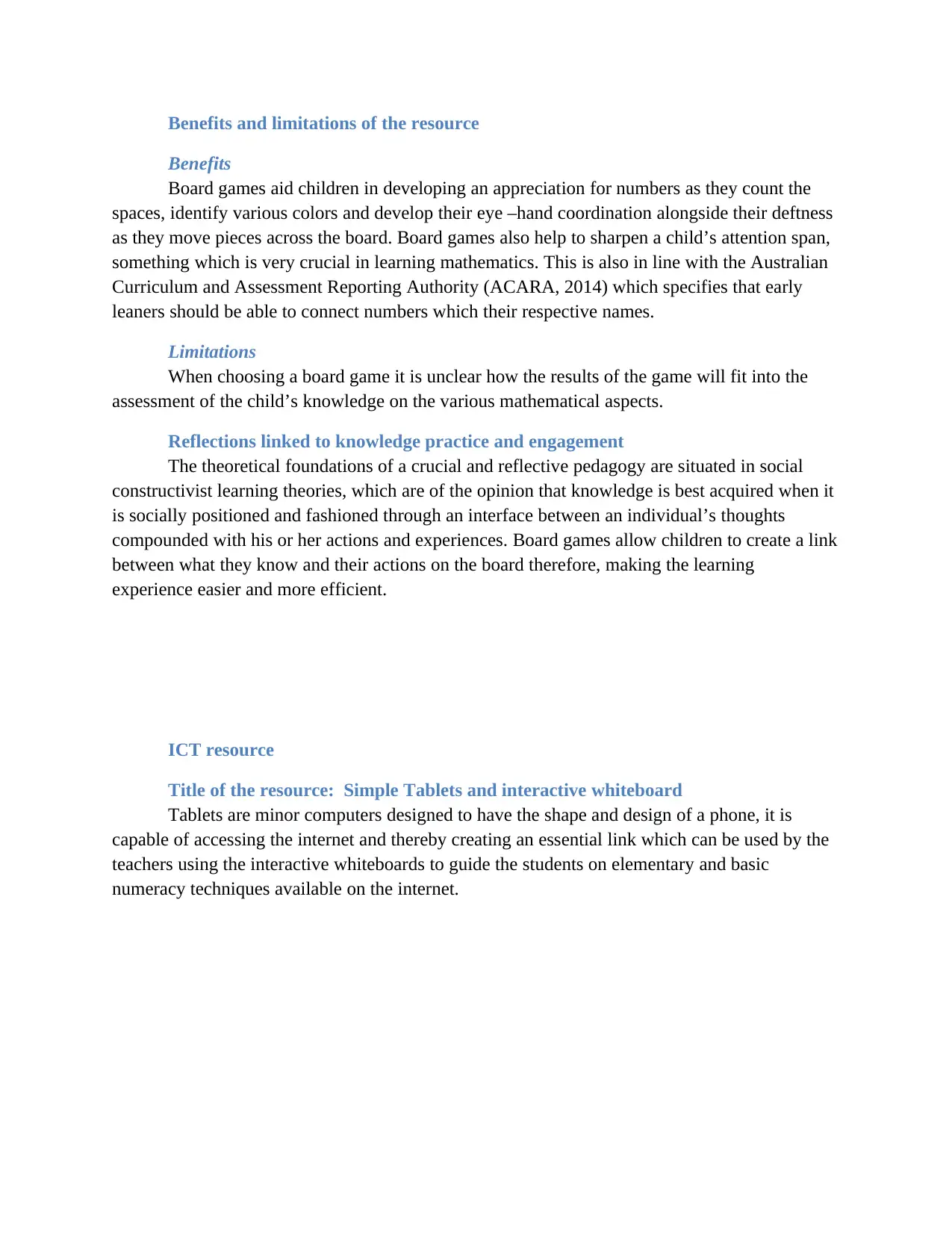
Benefits and limitations of the resource
Benefits
Board games aid children in developing an appreciation for numbers as they count the
spaces, identify various colors and develop their eye –hand coordination alongside their deftness
as they move pieces across the board. Board games also help to sharpen a child’s attention span,
something which is very crucial in learning mathematics. This is also in line with the Australian
Curriculum and Assessment Reporting Authority (ACARA, 2014) which specifies that early
leaners should be able to connect numbers which their respective names.
Limitations
When choosing a board game it is unclear how the results of the game will fit into the
assessment of the child’s knowledge on the various mathematical aspects.
Reflections linked to knowledge practice and engagement
The theoretical foundations of a crucial and reflective pedagogy are situated in social
constructivist learning theories, which are of the opinion that knowledge is best acquired when it
is socially positioned and fashioned through an interface between an individual’s thoughts
compounded with his or her actions and experiences. Board games allow children to create a link
between what they know and their actions on the board therefore, making the learning
experience easier and more efficient.
ICT resource
Title of the resource: Simple Tablets and interactive whiteboard
Tablets are minor computers designed to have the shape and design of a phone, it is
capable of accessing the internet and thereby creating an essential link which can be used by the
teachers using the interactive whiteboards to guide the students on elementary and basic
numeracy techniques available on the internet.
Benefits
Board games aid children in developing an appreciation for numbers as they count the
spaces, identify various colors and develop their eye –hand coordination alongside their deftness
as they move pieces across the board. Board games also help to sharpen a child’s attention span,
something which is very crucial in learning mathematics. This is also in line with the Australian
Curriculum and Assessment Reporting Authority (ACARA, 2014) which specifies that early
leaners should be able to connect numbers which their respective names.
Limitations
When choosing a board game it is unclear how the results of the game will fit into the
assessment of the child’s knowledge on the various mathematical aspects.
Reflections linked to knowledge practice and engagement
The theoretical foundations of a crucial and reflective pedagogy are situated in social
constructivist learning theories, which are of the opinion that knowledge is best acquired when it
is socially positioned and fashioned through an interface between an individual’s thoughts
compounded with his or her actions and experiences. Board games allow children to create a link
between what they know and their actions on the board therefore, making the learning
experience easier and more efficient.
ICT resource
Title of the resource: Simple Tablets and interactive whiteboard
Tablets are minor computers designed to have the shape and design of a phone, it is
capable of accessing the internet and thereby creating an essential link which can be used by the
teachers using the interactive whiteboards to guide the students on elementary and basic
numeracy techniques available on the internet.
Paraphrase This Document
Need a fresh take? Get an instant paraphrase of this document with our AI Paraphraser
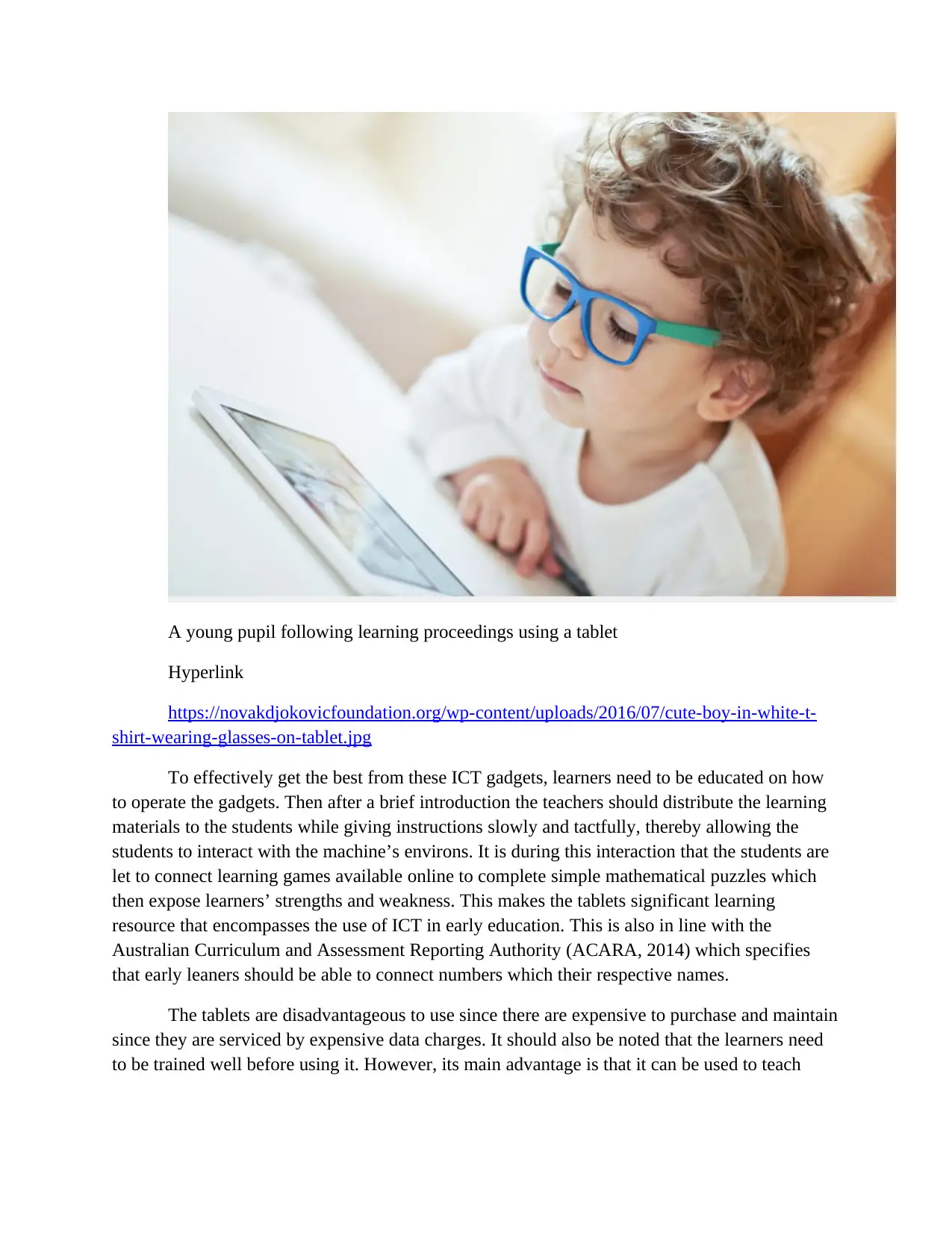
A young pupil following learning proceedings using a tablet
Hyperlink
https://novakdjokovicfoundation.org/wp-content/uploads/2016/07/cute-boy-in-white-t-
shirt-wearing-glasses-on-tablet.jpg
To effectively get the best from these ICT gadgets, learners need to be educated on how
to operate the gadgets. Then after a brief introduction the teachers should distribute the learning
materials to the students while giving instructions slowly and tactfully, thereby allowing the
students to interact with the machine’s environs. It is during this interaction that the students are
let to connect learning games available online to complete simple mathematical puzzles which
then expose learners’ strengths and weakness. This makes the tablets significant learning
resource that encompasses the use of ICT in early education. This is also in line with the
Australian Curriculum and Assessment Reporting Authority (ACARA, 2014) which specifies
that early leaners should be able to connect numbers which their respective names.
The tablets are disadvantageous to use since there are expensive to purchase and maintain
since they are serviced by expensive data charges. It should also be noted that the learners need
to be trained well before using it. However, its main advantage is that it can be used to teach
Hyperlink
https://novakdjokovicfoundation.org/wp-content/uploads/2016/07/cute-boy-in-white-t-
shirt-wearing-glasses-on-tablet.jpg
To effectively get the best from these ICT gadgets, learners need to be educated on how
to operate the gadgets. Then after a brief introduction the teachers should distribute the learning
materials to the students while giving instructions slowly and tactfully, thereby allowing the
students to interact with the machine’s environs. It is during this interaction that the students are
let to connect learning games available online to complete simple mathematical puzzles which
then expose learners’ strengths and weakness. This makes the tablets significant learning
resource that encompasses the use of ICT in early education. This is also in line with the
Australian Curriculum and Assessment Reporting Authority (ACARA, 2014) which specifies
that early leaners should be able to connect numbers which their respective names.
The tablets are disadvantageous to use since there are expensive to purchase and maintain
since they are serviced by expensive data charges. It should also be noted that the learners need
to be trained well before using it. However, its main advantage is that it can be used to teach
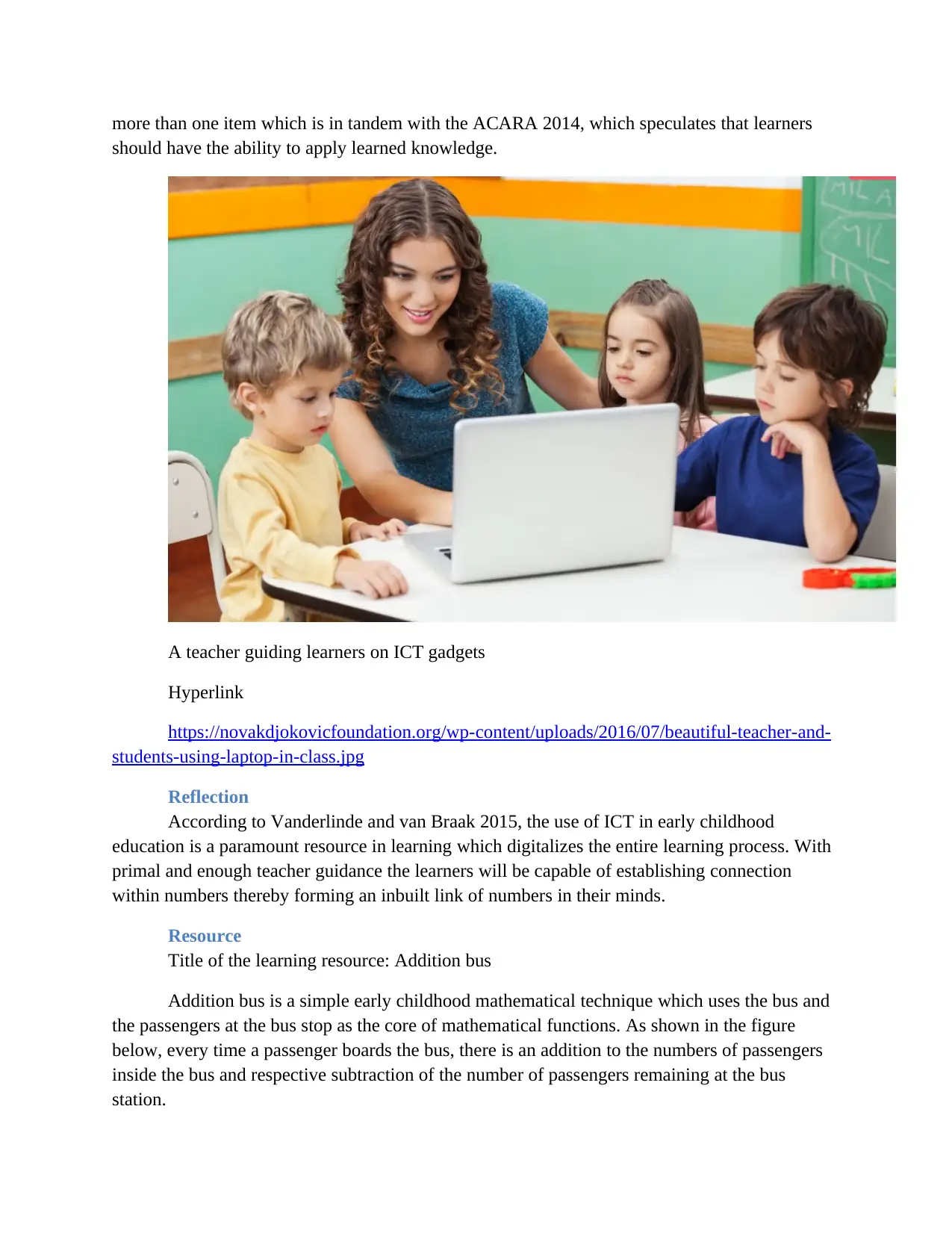
more than one item which is in tandem with the ACARA 2014, which speculates that learners
should have the ability to apply learned knowledge.
A teacher guiding learners on ICT gadgets
Hyperlink
https://novakdjokovicfoundation.org/wp-content/uploads/2016/07/beautiful-teacher-and-
students-using-laptop-in-class.jpg
Reflection
According to Vanderlinde and van Braak 2015, the use of ICT in early childhood
education is a paramount resource in learning which digitalizes the entire learning process. With
primal and enough teacher guidance the learners will be capable of establishing connection
within numbers thereby forming an inbuilt link of numbers in their minds.
Resource
Title of the learning resource: Addition bus
Addition bus is a simple early childhood mathematical technique which uses the bus and
the passengers at the bus stop as the core of mathematical functions. As shown in the figure
below, every time a passenger boards the bus, there is an addition to the numbers of passengers
inside the bus and respective subtraction of the number of passengers remaining at the bus
station.
should have the ability to apply learned knowledge.
A teacher guiding learners on ICT gadgets
Hyperlink
https://novakdjokovicfoundation.org/wp-content/uploads/2016/07/beautiful-teacher-and-
students-using-laptop-in-class.jpg
Reflection
According to Vanderlinde and van Braak 2015, the use of ICT in early childhood
education is a paramount resource in learning which digitalizes the entire learning process. With
primal and enough teacher guidance the learners will be capable of establishing connection
within numbers thereby forming an inbuilt link of numbers in their minds.
Resource
Title of the learning resource: Addition bus
Addition bus is a simple early childhood mathematical technique which uses the bus and
the passengers at the bus stop as the core of mathematical functions. As shown in the figure
below, every time a passenger boards the bus, there is an addition to the numbers of passengers
inside the bus and respective subtraction of the number of passengers remaining at the bus
station.
⊘ This is a preview!⊘
Do you want full access?
Subscribe today to unlock all pages.

Trusted by 1+ million students worldwide
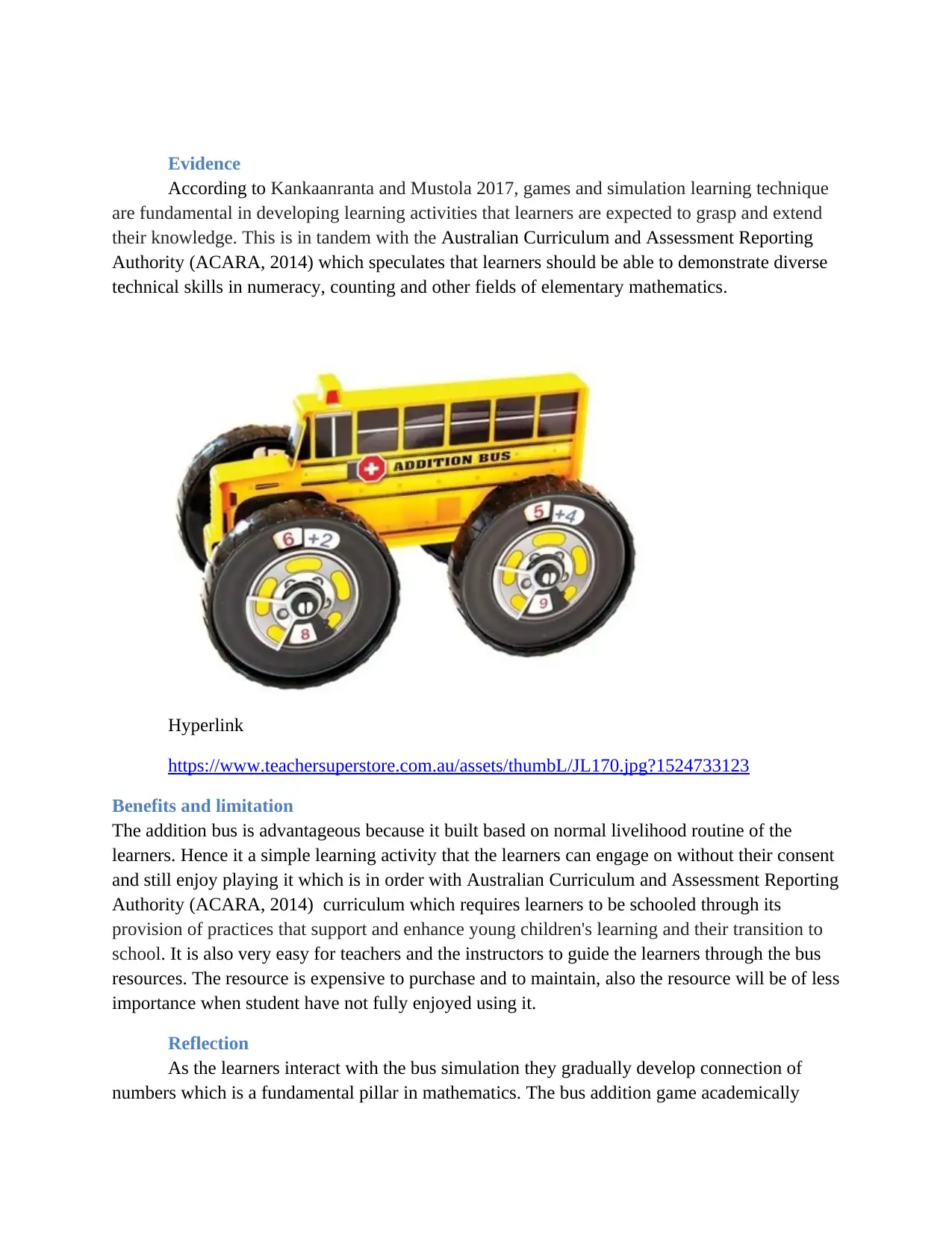
Evidence
According to Kankaanranta and Mustola 2017, games and simulation learning technique
are fundamental in developing learning activities that learners are expected to grasp and extend
their knowledge. This is in tandem with the Australian Curriculum and Assessment Reporting
Authority (ACARA, 2014) which speculates that learners should be able to demonstrate diverse
technical skills in numeracy, counting and other fields of elementary mathematics.
Hyperlink
https://www.teachersuperstore.com.au/assets/thumbL/JL170.jpg?1524733123
Benefits and limitation
The addition bus is advantageous because it built based on normal livelihood routine of the
learners. Hence it a simple learning activity that the learners can engage on without their consent
and still enjoy playing it which is in order with Australian Curriculum and Assessment Reporting
Authority (ACARA, 2014) curriculum which requires learners to be schooled through its
provision of practices that support and enhance young children's learning and their transition to
school. It is also very easy for teachers and the instructors to guide the learners through the bus
resources. The resource is expensive to purchase and to maintain, also the resource will be of less
importance when student have not fully enjoyed using it.
Reflection
As the learners interact with the bus simulation they gradually develop connection of
numbers which is a fundamental pillar in mathematics. The bus addition game academically
According to Kankaanranta and Mustola 2017, games and simulation learning technique
are fundamental in developing learning activities that learners are expected to grasp and extend
their knowledge. This is in tandem with the Australian Curriculum and Assessment Reporting
Authority (ACARA, 2014) which speculates that learners should be able to demonstrate diverse
technical skills in numeracy, counting and other fields of elementary mathematics.
Hyperlink
https://www.teachersuperstore.com.au/assets/thumbL/JL170.jpg?1524733123
Benefits and limitation
The addition bus is advantageous because it built based on normal livelihood routine of the
learners. Hence it a simple learning activity that the learners can engage on without their consent
and still enjoy playing it which is in order with Australian Curriculum and Assessment Reporting
Authority (ACARA, 2014) curriculum which requires learners to be schooled through its
provision of practices that support and enhance young children's learning and their transition to
school. It is also very easy for teachers and the instructors to guide the learners through the bus
resources. The resource is expensive to purchase and to maintain, also the resource will be of less
importance when student have not fully enjoyed using it.
Reflection
As the learners interact with the bus simulation they gradually develop connection of
numbers which is a fundamental pillar in mathematics. The bus addition game academically
Paraphrase This Document
Need a fresh take? Get an instant paraphrase of this document with our AI Paraphraser
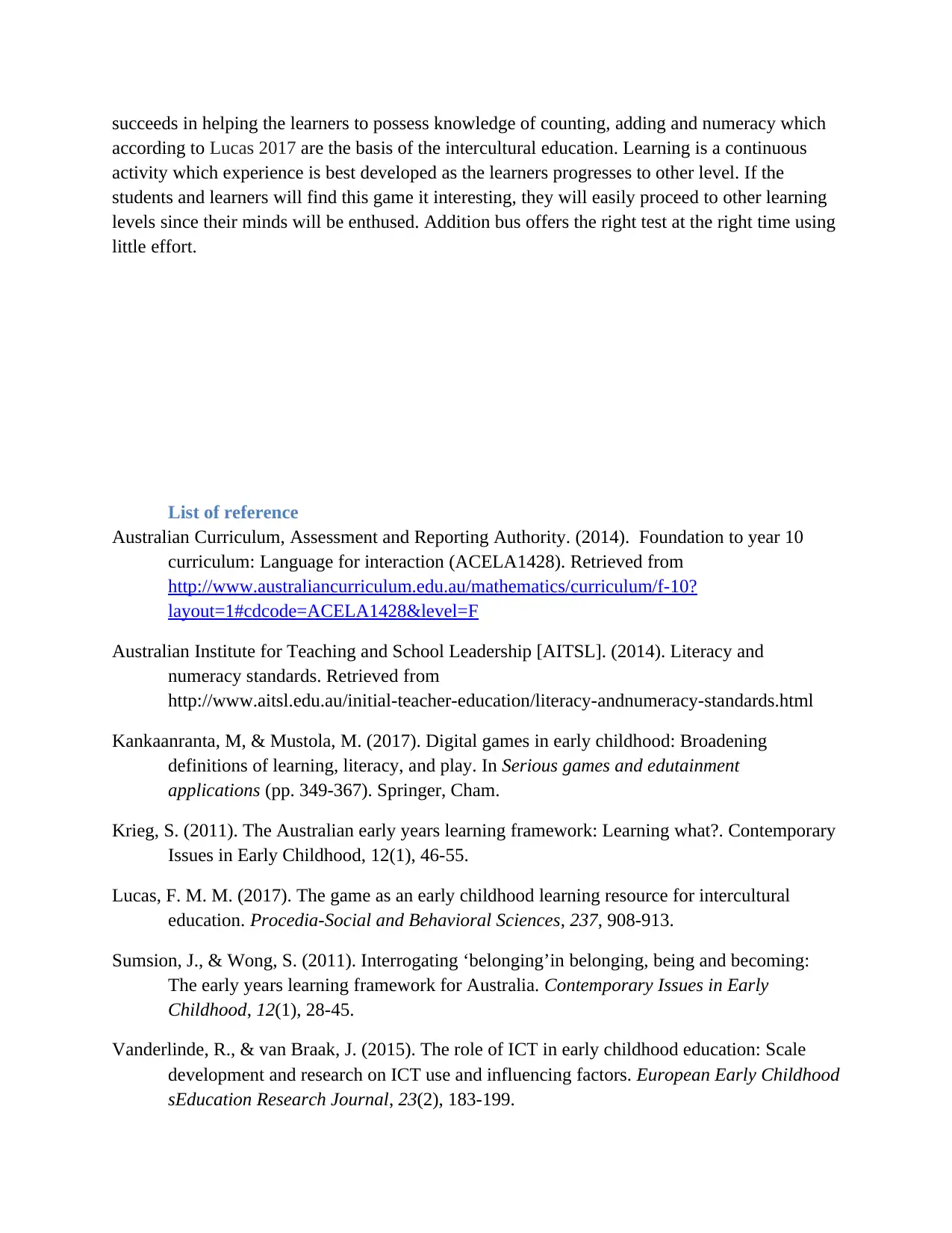
succeeds in helping the learners to possess knowledge of counting, adding and numeracy which
according to Lucas 2017 are the basis of the intercultural education. Learning is a continuous
activity which experience is best developed as the learners progresses to other level. If the
students and learners will find this game it interesting, they will easily proceed to other learning
levels since their minds will be enthused. Addition bus offers the right test at the right time using
little effort.
List of reference
Australian Curriculum, Assessment and Reporting Authority. (2014). Foundation to year 10
curriculum: Language for interaction (ACELA1428). Retrieved from
http://www.australiancurriculum.edu.au/mathematics/curriculum/f-10?
layout=1#cdcode=ACELA1428&level=F
Australian Institute for Teaching and School Leadership [AITSL]. (2014). Literacy and
numeracy standards. Retrieved from
http://www.aitsl.edu.au/initial-teacher-education/literacy-andnumeracy-standards.html
Kankaanranta, M, & Mustola, M. (2017). Digital games in early childhood: Broadening
definitions of learning, literacy, and play. In Serious games and edutainment
applications (pp. 349-367). Springer, Cham.
Krieg, S. (2011). The Australian early years learning framework: Learning what?. Contemporary
Issues in Early Childhood, 12(1), 46-55.
Lucas, F. M. M. (2017). The game as an early childhood learning resource for intercultural
education. Procedia-Social and Behavioral Sciences, 237, 908-913.
Sumsion, J., & Wong, S. (2011). Interrogating ‘belonging’in belonging, being and becoming:
The early years learning framework for Australia. Contemporary Issues in Early
Childhood, 12(1), 28-45.
Vanderlinde, R., & van Braak, J. (2015). The role of ICT in early childhood education: Scale
development and research on ICT use and influencing factors. European Early Childhood
sEducation Research Journal, 23(2), 183-199.
according to Lucas 2017 are the basis of the intercultural education. Learning is a continuous
activity which experience is best developed as the learners progresses to other level. If the
students and learners will find this game it interesting, they will easily proceed to other learning
levels since their minds will be enthused. Addition bus offers the right test at the right time using
little effort.
List of reference
Australian Curriculum, Assessment and Reporting Authority. (2014). Foundation to year 10
curriculum: Language for interaction (ACELA1428). Retrieved from
http://www.australiancurriculum.edu.au/mathematics/curriculum/f-10?
layout=1#cdcode=ACELA1428&level=F
Australian Institute for Teaching and School Leadership [AITSL]. (2014). Literacy and
numeracy standards. Retrieved from
http://www.aitsl.edu.au/initial-teacher-education/literacy-andnumeracy-standards.html
Kankaanranta, M, & Mustola, M. (2017). Digital games in early childhood: Broadening
definitions of learning, literacy, and play. In Serious games and edutainment
applications (pp. 349-367). Springer, Cham.
Krieg, S. (2011). The Australian early years learning framework: Learning what?. Contemporary
Issues in Early Childhood, 12(1), 46-55.
Lucas, F. M. M. (2017). The game as an early childhood learning resource for intercultural
education. Procedia-Social and Behavioral Sciences, 237, 908-913.
Sumsion, J., & Wong, S. (2011). Interrogating ‘belonging’in belonging, being and becoming:
The early years learning framework for Australia. Contemporary Issues in Early
Childhood, 12(1), 28-45.
Vanderlinde, R., & van Braak, J. (2015). The role of ICT in early childhood education: Scale
development and research on ICT use and influencing factors. European Early Childhood
sEducation Research Journal, 23(2), 183-199.
1 out of 8
Your All-in-One AI-Powered Toolkit for Academic Success.
+13062052269
info@desklib.com
Available 24*7 on WhatsApp / Email
![[object Object]](/_next/static/media/star-bottom.7253800d.svg)
Unlock your academic potential
Copyright © 2020–2026 A2Z Services. All Rights Reserved. Developed and managed by ZUCOL.

